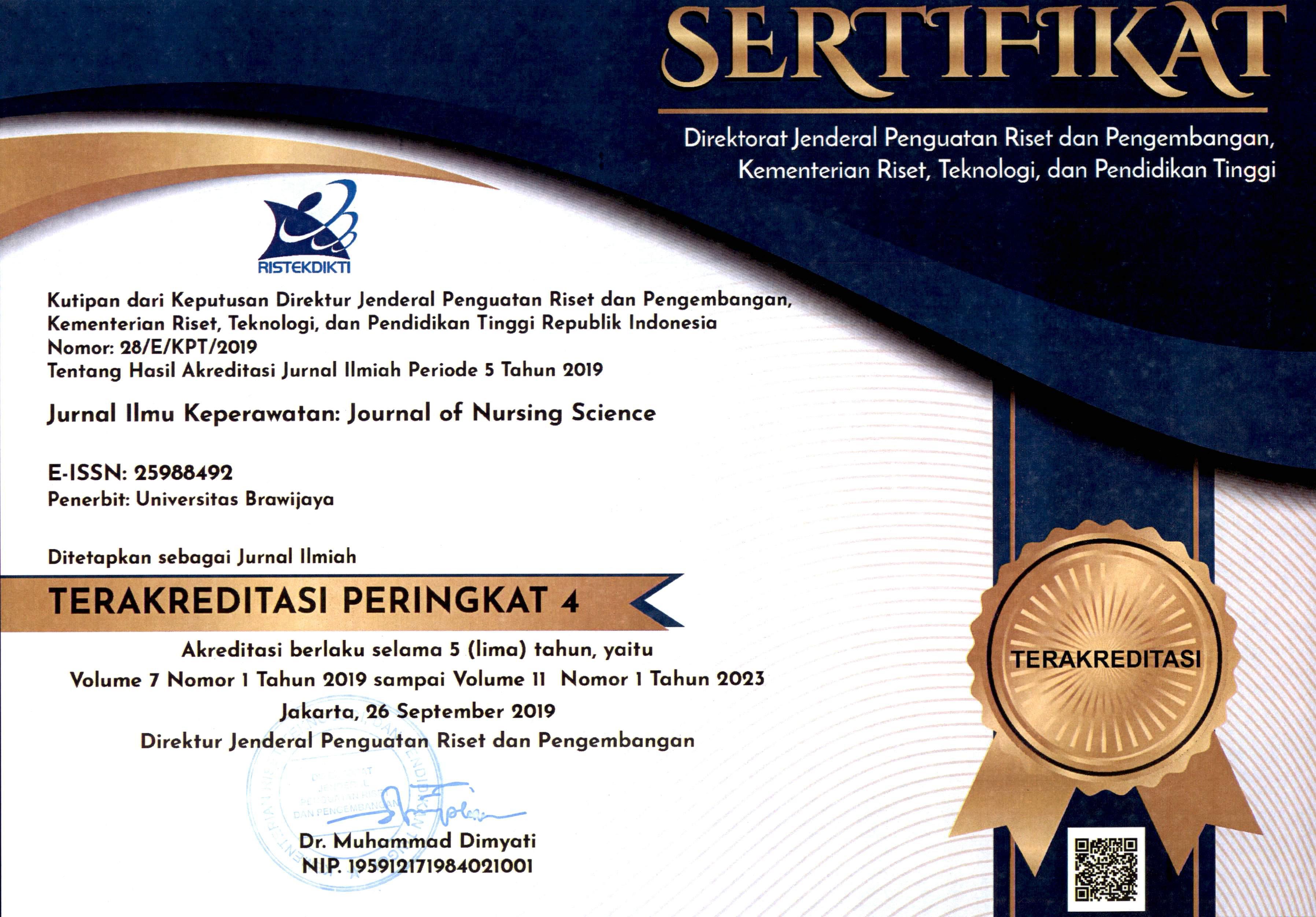THE EFFECT OF SPIRITUALITY ON THE SYNDROME OF BURN OUT AND NURSE TURNOVER INTENTION AT THE ISLAMIC HOSPITAL OF GONDANGLEGI MALANG
DOI:
https://doi.org/10.21776/ub.jik.2019.007.02.2Keywords:
spirituality, burn out, nurse turnover intentionAbstract
occurrence of burn out and turnover intention.
References
- Akintola, O., Hlengwa, W. M. dan Dageid, W. (2013) ‘Perceived stress dan burnout among volunteer caregivers working in AIDS care in S outh A frica’, Journal of advanced nursing. Wiley Online Library, 69(12), pp. 2738–2749.
- Ariyani (2009) ‘Analisis pengetahuan dan motivasi perawat yang mempengaruhi sikap mendukung penerapan program patient safety di instalasi perawatan intensif rsud dr. moewardi surakarta tahun 2008’, pp. 1–125.
- Davis, S., Lind, B. K. dan Sorensen, C. (2013) ‘A comparison of burnout among oncology nurses working in adult dan pediatric inpatient dan outpatient settings.’, in Oncology Nursing Forum.
- Doraiswamy, I. R. dan Deshmukh, M. (2015) ‘Workplace spirituality dan role stress among nurses in India’, IOSR Journal of Nursing dan Health Science, 4(4), pp. 6–13.
- DuBrin, A. J. dan Geerinck, T. (2015) Human relations: Interpersonal, job-oriented skills. Pearson.
- Ema, A. (2004) ‘Peranan dimensi-dimensi birokrasi terhadap burnout pada perawat rumah sakit di Jakarta’, Jurnal Psyche, 1(1), pp. 33–46.
- Ghadi, M. Y. (2017) ‘The impact of workplace spirituality on voluntary turnover intentions through loneliness in work’, Journal of Economic dan Administrative Sciences. Emerald Publishing Limited, 33(1), pp. 81–110.
- Ghosh, N. (2013) ‘Workplace spirituality-a tool to increase organizational emotional quotient’, International Journal of Research in Management Sciences, 1(2), pp. 1–10.
- Golden, J. et al. (2004) ‘Spirituality dan burnout: An incremental validity study’, Journal of Psychology dan Theology. SAGE Publications Sage UK: London, Engldan, 32(2), pp. 115–125.
- Greenberg, J. dan Baron, R. A. (2009) Behavior in organizations: understdaning dan managing the human side of work. Prentice Hall.
- Griffiths, P. (1998) ‘An investigation into the description of patients’ problems by nurses using two different needsâ€based nursing models’, Journal of Advanced Nursing. Wiley Online Library, 28(5), pp. 969–977.
- Iqbal, Q. dan Hassan, S. H. (2016) ‘Role of workplace spirituality: Personality traits dan counterproductive workplace behaviors in banking sector’, International Journal of Management, Accounting dan Economics, 3(12), pp. 806–821.
- Lee, T.-R. et al. (2010) ‘The relationship between spiritual management dan determinants of turnover intention’, European Business Review. Emerald Group Publishing Limited, 22(1), pp. 102–116.
- Malliarou, M. M., Moustaka, E. C. dan Konstantinidis, T. C. (2008) ‘BURNOUT OF NURSING PERSONNEL IN A REGIONAL UNIVERSITY HOSPITAL.’, Health Science Journal, 2(3).
- Maslach, C. dan Leiter, M. P. (2008) The truth about burnout: How organizations cause personal stress dan what to do about it. John Wiley & Sons.
- Maslach, C., Schaufeli, W. B. dan Leiter, M. P. (2001) ‘Job burnout’, Annual review of psychology. Annual Reviews 4139 El Camino Way, PO Box 10139, Palo Alto, CA 94303-0139, USA, 52(1), pp. 397–422.
- Nur, M. (2016) ‘Beban kerja padat perawat tetap wajib senyum’, Jawa Pos. Available at: http://www.jawapos.com/read/2016/11/12/63798/beban-kerja-padat perawat -tetapwajib-senyum.
- Papalia, D. E., Olds, S. W. dan Feldman, R. D. (2007) Human development. McGraw-Hill.
- Praptianingsih, S. (2006) ‘Kedudukan hukum perawat dalam upaya pelayanan kesehatan di rumah sakit’, Jakarta: PT Raja Grafindo Persada.
- Pratiwi, A. K. dan Nurtjahjanti, H. (2018) ‘HUBUNGAN ANTARA SPIRITUALITAS KERJA DENGAN BURNOUT PADA PERAWAT RAWAT INAP RSI SULTAN AGUNG KOTA SEMARANG’, Empati, 7(1), pp. 269–273.
- Schaufeli, W. B. dan Janczur, B. (1994) ‘Burnout among nurses: A Polish-Dutch comparison’, Journal of cross-cultural psychology. Sage Publications Sage CA: Thousdan Oaks, CA, 25(1), pp. 95–113.
- Shaw, J. D., Gupta, N. dan Delery, J. E. (2005) ‘Alternative conceptualizations of the relationship between voluntary turnover dan organizational performance’, Academy of management journal. Academy of Management Briarcliff Manor, NY 10510, 48(1), pp. 50–68.
- Simmons, B., Nelson, D. dan Neal, L. (2001) ‘A comparison of the positive dan negative work attitudes of home health care dan hospital nurses’, Health care management review. LWW, 26(3), pp. 63–74.
- Spector, P. (1996) ‘Industrialdan Organizational Psychology: Researchdan Practice’, USA: John Wiley&Sons Inc. Publications.
- Swider, B. W. dan Zimmerman, R. D. (2010) ‘Born to burnout: A meta-analytic path model of personality, job burnout, dan work outcomes’, Journal of Vocational Behavior. Elsevier, 76(3), pp. 487–506.
- Tawale, E. N., Budi, W. dan Nurcholis, G. (2011) ‘Hubungan antara Motivasi Kerja Perawat dengan Kecenderungan mengalami Burnout pada Perawat di RSUD Serui–Papua’, Jurnal Insan, 13(2), pp. 74–84.
- Undang-Undang Republik Indonesia Nomor 44 Tahun 2009 Tentang Rumah Sakit. Indonesia
- Wilski, M., Chmielewski, B. dan Tomczak, M. (2015) ‘Work locus of control dan burnout in Polish physiotherapists: The mediating effect of coping styles’, International journal of occupational medicine dan environmental health. Nofer Institute of Occupational Medicine, 28(5), p. 875.
Downloads
Published
How to Cite
License
Authors published in this journal agree to the following terms:
1. The copyright of the received article shall be assigned to the journal as the publisher of the journal. The intended copyright includes the right to publish the article in various forms (including reprints). The journal maintains the publishing rights to the published articles.
2. Authors may enter into separate additional contractual agreements for the non-exclusive distribution of the published journal version of the work (for example, posting it to an institutional repository or publishing it in a book), with acknowledgment of their initial publication in this journal.
3. Authors are permitted and encouraged to post their work online (e.g. in an Institutional Repository or on their website) before and during the submission process, as this can result in a productive exchange, as well as earlier and larger citations of the published work.
4. Articles and all related material published are distributed under Creative Commons Attribution-NonCommercial 4.0 International License or CC BY-NC 4.0 license.
JNSU is licensed under a Creative Commons Attribution-NonCommercial 4.0 International License or CC BY-NC 4.0 license.





























